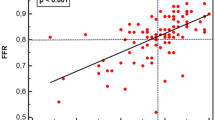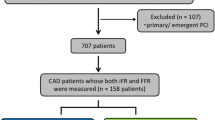Abstract
Background: The present study was conducted to examine whether it is possible to differentiate patients with aortic stenosis (AOS) with or without significant stenosis of the left anterior descending coronary artery (LAD) on the basis of the age, gender, hypertension, diabetes mellitus, hypercholesterolemia, the coronary flow velocity reserve (CFVR) and the grade of aortic atherosclerosis (AA) evaluated by TEE in the course of the same semi-invasive examination. Patients and methods: Thirty-nine consecutive AOS patients who had undergone coronary angiography were examined by dipyridamole stress TEE to assess the CFVR. From this patient population, 21 AOS patients with anatomically normal coronary arteries (group 1), and 18 AOS patients with >75% stenosis of the LAD (group 2) were selected for the present study. The CFVR was calculated as the ratio of the average peak diastolic flow velocity (APV) during hyperemia to the resting APV. The grade of AA in the descending aorta was determined by means of the same TEE examination. Results: The demographic, clinical and transthoracic echocardiographic data, the coronary flow velocities and the CFVRs were similar in the two patient groups. Only the grade of AA (ROC area, 73%, p <0.02) appears useful for the distinction of AOS patients with or without significant LAD stenosis. Conclusions: These results demonstrate that only the grade of AA furnishes additional help in the prediction of AOS patients with severe LAD disease. CFVR has no any diagnostic power in the differentiation of AOS patients with or without significant LAD stenosis.
Similar content being viewed by others
References
Nemes A, Forster T, Varga A, et al. How can the coronary flow reserve be altered by severe aortic stenosis? Echocardiography 2002; 19: 655–659.
Nemes A, Forster T, Kovás Z, Thury A, Ungi I, Csanády M. The effect of aortic valve replacement on coronary flow reserve in patients with a normal coronary angiogram. Herz 2002; 27: 780–784.
Hildick-Smith DJ, Shapiro LM. Coronary flow reserve improves after aortic valve replacement for aortic stenosis: an adenosine transthoracic echocardiographic study. J Am Coll Cardiol 2000; 36: 1889–1896.
Rajappan K, Rimoldi OE, Dutka DP, et al. Mechanism of coronary microcirculatory dysfunction in patients with aortic stenosis and angiographically normal coronary arteries. Circulation 2002; 105: 470–476.
Kawamoto R, Imamura T, Kawabata K, et al. Microvascular angina in a patient with angina pectoris. Jpn Circ J 2001; 65: 839–841.
Julius BK, Spillmann M, Vassali G, Villari B, Eberli FR, Hess OM. Angina pectoris in patients with aortic stenosis and normal coronary arteries. Mechanisms and pathophysiological concepts. Circulation 1997; 95: 892–898.
Marcus ML, Doty DB, Hiratzka LF, Wright CB, Eastham CL. Decreased coronary reserve: a mechanism for angina pectoris with aortic stenosis in patients and normal coronary arteries. N Eng J Med 1982; 307: 1362–1366.
Eberli FR, Ritter M, Schwitter J, et al. Coronary reserve in patients with aortic valve disease before and after successful aortic valve replacement. Eur Heart J 1991; 12: 127–138.
Parthenakis FI, Kochiadakis G, Skalidis EI, et al. Aortic atherosclerotic lesions in the thoracic aorta detected by multiplane transesophageal echocardiography as a predictor of coronary artery disease in the elderly patients. Clin Cardiol 2000; 23: 734–739.
Matsumura Y, Takata J, Yabe T, Furuno T, Chikamori T, Doi YL. Atherosclerotic aortic plaque detected by transesophageal echocardiography: its significance and limitation as a marker for coronary artery disease in the elderly. Chest 1997; 112: 81–86.
Tribouilloy C, Peltier M, Senni M, Colas L, Rey JL, Lesbre JP. Multiplane transesophageal echocardiographic detection of thoracic aortic plaque is a marker for coronary artery disease in women. Int J Cardiol 1997; 61: 269–275.
Khoury Z, Gottlieb S, Stern S, Keren A. Frequency and distribution of atherosclerotic plaques in the thoracic aorta as determined by transesophageal echocardiography in patients with coronary artery disease. Am J Cardiol 1997; 79: 23–27.
Acarturk E, Demir M, Kanadasi M. Aortic atherosclerosis is a marker for significant coronary artery disease. Jpn Heart J 1999; 40: 775–781.
Fazio GP, Redberg RF, Winslow T, Schiller NB. Transesophageal echocardiographically detected atherosclerotic aortic plaque is a marker for coronary artery disease. J Am Coll Cardiol 1993; 21: 144–150.
Parthenakis F, Skalidis E, Simantirakis E, Kounali D, Vardas P, Nihoyannopoulos P. Absence of atherosclerotic lesions in the thoracic aorta indicates absence of significant coronary artery disease. Am J Cardiol 1996; 77: 1118–1121.
Tribouilloy C, Shen W, Peltier M, Lesbre JP. Noninvasive prediction of coronary artery disease by transesophageal detection of thoracic aortic plaque in valvular heart disease. Am J Cardiol 1994; 74: 258–260.
Tribouilloy C, Peltier M, Colas L, Rida Z, Rey JL, Lesbre JP. Multiplane transesophageal echocardiographic absence of thoracic aortic plaque is a powerful predictor for absence of significant coronary artery disease in valvular patients, even in the elderly. A large prospective study. Eur Heart J 1997; 18: 1478–1483.
Tribouilloy C, Peltier M, Rey JL, Riuz V, Lesbre JP. Use of transesophageal echocardiography to predict significant coronary artery disease in aortic stenosis. Chest 1998; 113: 671–675.
Devereux RB, Reichek N. Echocardiographic determination of left ventricular mass in man: anatomic validation of the method. Circulation 1977; 55: 613–618.
Du Bois D, Du Bois EF. A formula to estimate the approximate surface area if height and weight be known. Arch Intern Med 1916; 17: 863–871.
Iliceto S, Marangelli V, Memmola C, Rizzon P. Transesophageal Doppler echocardiography evaluation of coronary blood flow velocity in baseline conditions and during dipyridamole-induced coronary vasodilation. Circulation 1991; 83: 61–69.
Demirkol MO, Yaymaci B, Debes H, Basaran Y, Turan F. Dipyridamol myocardial perfusion tomography in patients with severe aortic stenosis. Cardiology 2002; 97: 37–42.
Plonska E, Szyszka A, Kasprzak J, et al. Side effects during dobutamine stress echocardiography in patients with aortic stenosis. Pol Merkuriusz Lek 2001; 11: 406–410.
Avakian SD, Grinberg M, Meneguetti JC, Ramires JA, Mansu AP. SPECT dipyridamole scintigraphy for detecting coronary artery disease in patients with isolated severe aortic stenosis. Int J Cardiol 2001; 81: 21–27.
Patsilinakos SP, Kranidis AI, Antonelis IP, et al. Detection of coronary artery disease in patients with severe aortic stenosis with noninvasive methods. Angiology 1999; 50: 309–317.
Maffei S, Baroni M, Terrazzi M, Paoli F, Ferrazzi P, Biagini A. Preoperative assessment of coronary artery disease in aortic stenosis a dipyridamole echocardiographic study. Ann Thorac Surg 1998; 65: 397–402.
Author information
Authors and Affiliations
Rights and permissions
About this article
Cite this article
Nemes, A., Forster, T., Thury, A. et al. The comparative value of the aortic atherosclerosis and the coronary flow velocity reserve evaluated by stress transesophageal echocardiography in the prediction of patients with aortic stenosis with coronary artery disease. Int J Cardiovasc Imaging 19, 371–376 (2003). https://doi.org/10.1023/A:1025829925910
Issue Date:
DOI: https://doi.org/10.1023/A:1025829925910




